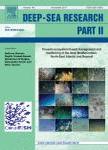版权所有:内蒙古大学图书馆 技术提供:维普资讯• 智图
内蒙古自治区呼和浩特市赛罕区大学西街235号 邮编: 010021

作者机构:Norwegian Polar Res Inst N-9296 Tromso Norway
出 版 物:《DEEP-SEA RESEARCH PART II-TOPICAL STUDIES IN OCEANOGRAPHY》 (深海研究,第二辑:海洋学专题研究)
年 卷 期:2008年第55卷第20-21期
页 面:2292-2307页
核心收录:
基 金:Research Council of Norway 150356-S30 155936-700
主 题:Sympagic ecosystem Ice fauna Carbon flux Fram Strait Barents Sea Svalbard
摘 要:Diversity and distribution of ice amphipods were determined in drifting sea ice around Svalbard during May-August 2003-2005. Sea-ice concentrations were determined visually and by satellite recordings. Backward trajectories for ice drift, based on satellite observations, indicated that multi-year ice in the area had originated 3-5 years earlier in the Kara Sea and western Laptev Sea, whereas some of the younger ice (1-2 years) may have originated in Franz Josef Land area. Quantitative collections of ice amphipods were obtained by SCUBA divers from flat areas and ridges below sea ice. The abundance and biomass were generally higher on ridges, particularly for the large Gammarus wilkitzkii, whereas Apherusa glacialis was more abundant on flat areas. Abundance and biomass varied among seasons (May-August) and years, with low values in May and higher values in July. The high values were similar to abundance and biomass values from July 1996. Redundancy analysis showed that 33% and 52% of the variability in respective species abundance and biomass could be explained by environmental variables, with ice draft and snow cover being the most important. The overall mean biomass for flats (0.30 +/- 0.05 g m(-2)) and ridges (1.64+0.46 g m(-2)) were used to calculate ice-associated biomass transport based on revised mean annual ice flux through Fram Strait (662,000 km(2) yr(-1)) and into the Barents Sea (total 228,000 km(2) yr(-1)). About 478 x 10(3)t\WW (57 x 10(3) tC) of ice amphipods are transported annually through Fram Strait and 194 x 10(3)t WW (23 x 10(3) tC) into the northern Barents Sea, implying that 71% of the amphipod biomass in drifting sea ice passes through Fram Strait and 29% enters the Barents Sea. Climate induced reduction in ice thickness and extent will likely decrease this southward biomass transport, and thus the current carbon input of about 80 x 10(3)t Cyr(-1) into these marginal seas. Ice amphipod populations probably cannot be sustained if the summers b